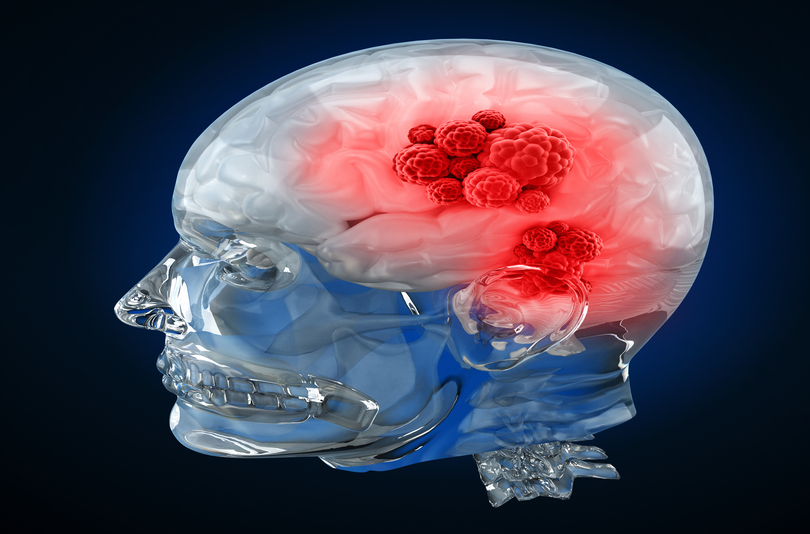

Brain tumor is an abnormal growth that originates in the brain or a metastatic tumor that has migrated from tumor cells that have originated in other distant parts of the body. It may occur in any tissue contained in the skull, including the brain, the cranial nerves, the meninges, pituitary gland, and the pineal gland.


Doctors diagnose brain tumor by conducting the neurological exam and tests like MRI, CT scan, and biopsy. Read more on diagnosis here.
Treatment options need to be explored after watchful waiting and they include surgery. Radiotherapy, chemotherapy and targeted therapy. A combination of the different types of treatment procedures is usually prescribed. Read more on treatment options.
Patients most commonly present with signs of intracranial pressure (e.g., headache, mood swings, nausea, vomiting and gait abnormality. Read more on symptoms here.
According to the National Brain Tumor Society, there are over 120 different types of brain tumors. The most common of which are gliomas that originate in the glial (supportive) tissue. About a third of all primary brain tumors and other nervous system tumors form from glial cells.
Primary brain tumors develop from cells contained inside the brain. As part of the central nervous system, the brain is the control center of vital body functions such as thought, emotions, memory, vision, speech, hearing, movement, etc. Primary brain tumors are classified based on the grade, location and type of cell or tissue that it affects. It is generally observed that tumor cells of the brain spread across short distances from the origin but do not travel outside the brain itself.
When cancer that originates elsewhere metastasizes to the brain it is called secondary brain tumor. Common regions from where tumor metastasizes to the brain are lung, colon, kidney and breast cancers.
Apart from tumors in the brain, cancers may begin or spread to other parts of the central nervous system, such as the spinal cord or column, or peripheral nerves. Cancers that develop in or around the spinal cord is called spinal cancer, most of which are metastatic tumors (which have spread to the spine from other locations in the body.
A risk factor is that which increases the chance of getting a disease. Research studies show the following risk factors for brain tumors:
It is a high dose of X -rays that can cause cell damage, leading to brain tumor. People exposed to ionization radiation may have increases risk of brain tumors like meningioma or glioma.
Exposure to industrial chemicals or solvents is associated with the increase in the risk of developing brain cancer. Although there is no conclusive evidence, there is higher risk for individuals who work in oil refining rubber manufacturing and drug manufacturing industries.
The incidence rate for this is low, and only a small number of families have several members with brain tumors. Von Hippel-Lindau disease, Li-Fraumeni syndrome, and Neurofibromatosis (NF1 and NF2) are inherited conditions found in histories of patient families.
While there is no rule of thumb for brain cancers in males or females it has been noted that meningiomas are twice as likely to develop in women and medulloblastomas are more frequently reported in men.
In general, the frequency of brain cancer occurrences in older people is high. The age factor differs according to the type and location of the cell. For example, adults have a very low risk of developing medulloblastomas, gliomas are most common in adults. The occurrence of meningiomas and craniopharyngiomas are more frequent in adults over the age 50. It is still reported that these tumors may occur at any age.
Low immunity in people can increase the risk of developing lymphomas in the brain.
Some of the symptoms of brain tumor are:
While there is no known action to prevent brain cancer, vinyl chloride is an established risk factor of brain tumor. There are a few factors that may tend to raise the risk of brain cancer. Prevention can be possible with the following:
The following are measures of diagnosis of brain tumors.
A neuro-exam determines the cause of the symptoms. They consist of neurological vision and hearing tests, neurocognitive assessment, and electroencephalography.
Diagnosing brain tumor usually begins with an MRI scan, which uses magnetic rays to diagnose tumor. It is used to measure the tumor size. The results of the neuro exam are taken into consideration and an MRI is carried further.
A sample of tumor tissue is obtained for full diagnosis. A biopsy is a process by which a small amount of tumor tissue is removed for examination under a microscope. A biopsy may be used as part of surgery or aside from surgery, as prescribed by the healthcare team.
Other forms of diagnosis to identify how well tumors are working are:
Brain and spinal cord tumors require a panel of health experts and oncologists who are headed by a neurosurgeon. THe following are a list of health professionals that the treatment requires: